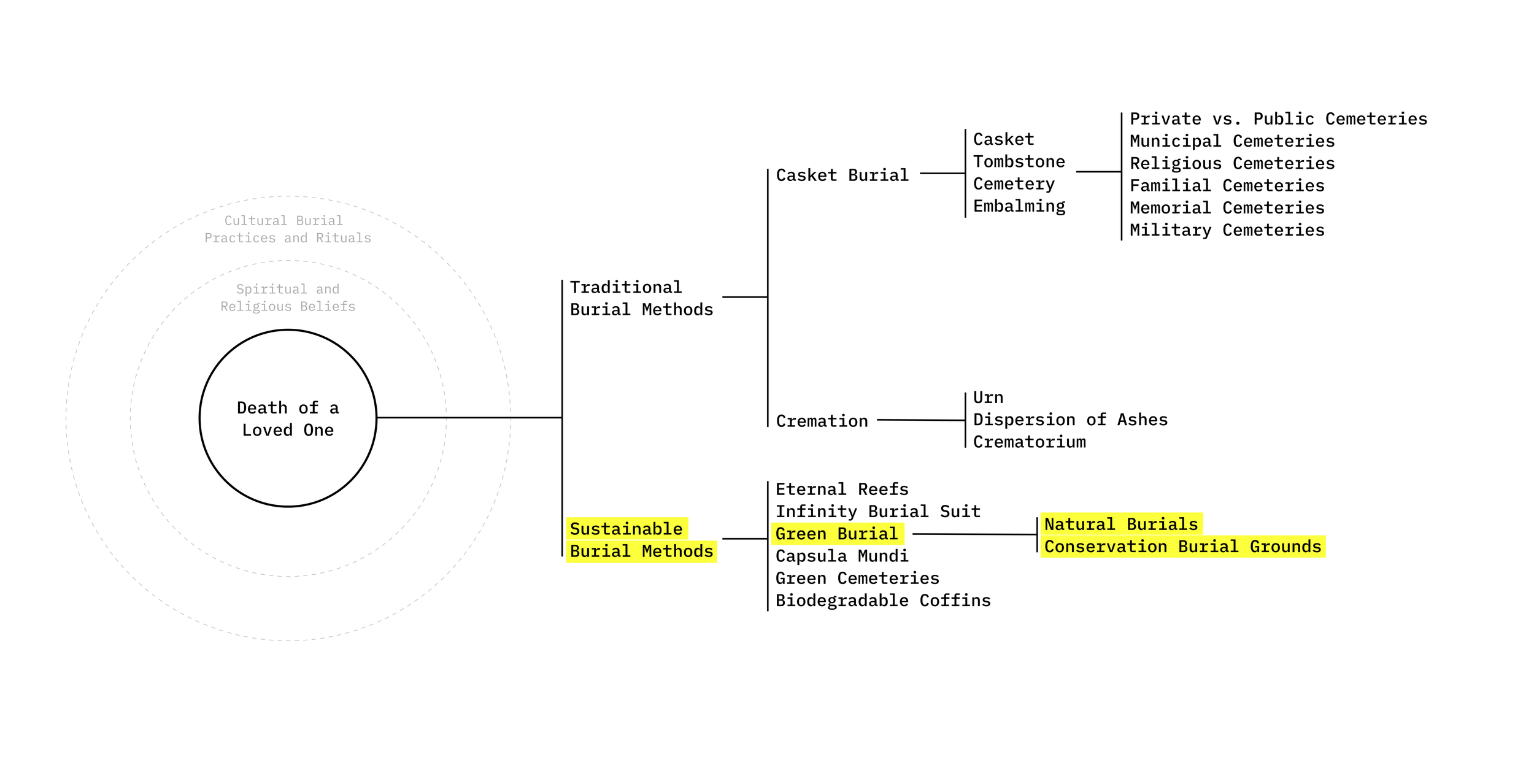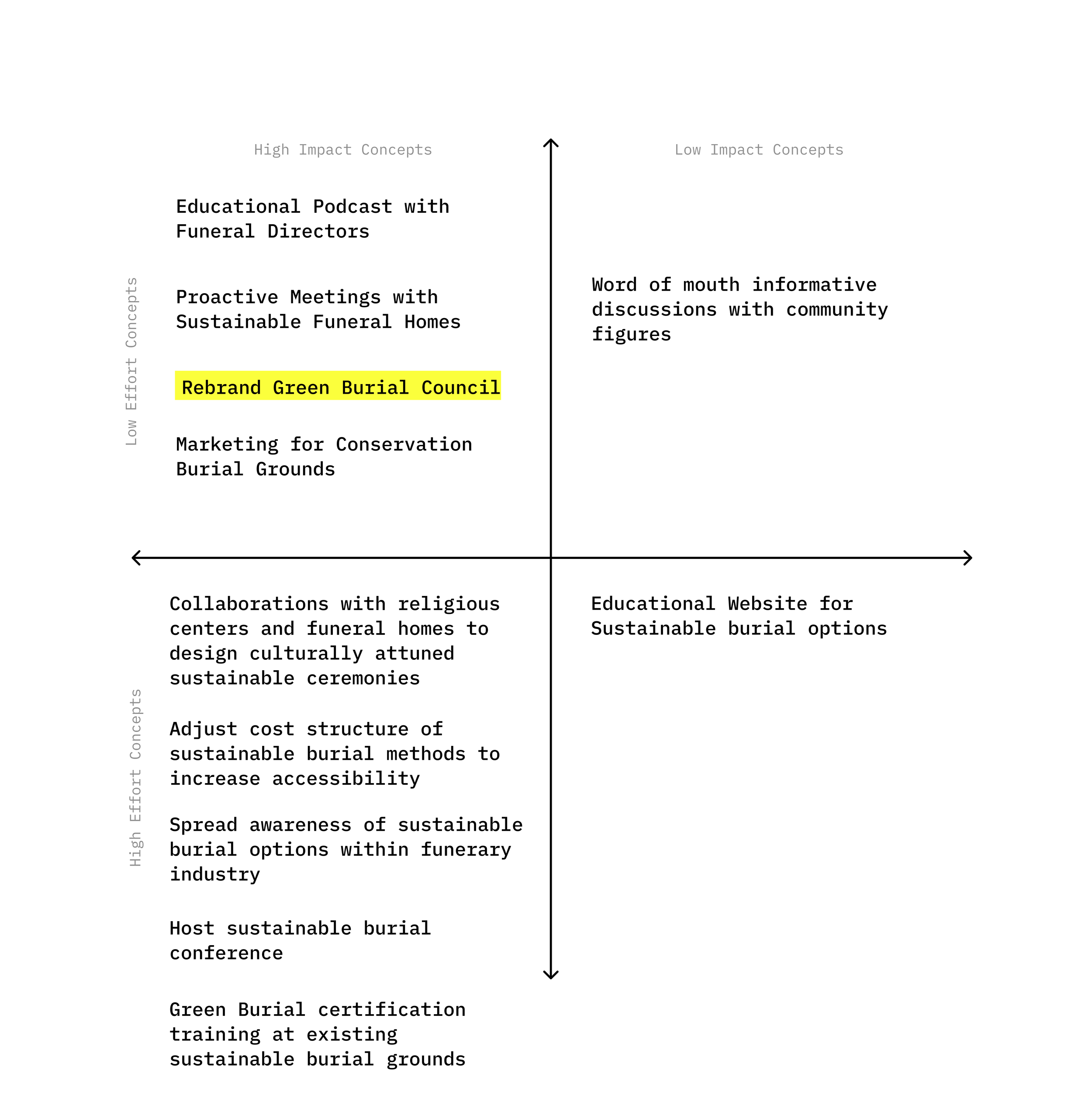
O V E R V I E W
Problem
The linearity of death doesn’t match the circularity that sustainability demands.
Death is an inevitable part of life's circulatory systems. However, in Western culture, burial has been made into an ecologically damaging process that doesn't actively utilize existing opportunities for sustainable practices.
P R O J E C T
Outcome
Sustainable Burial Practices
How can we reimagine and redesign burial rituals and practices to be reacquainted with circularity, and utilize sustainable processes in order to minimize environmental impact and help to nurture natural environmental systems?
C O N T E X T
Team
Sherry Quan, Industrial Designer
Abbey Hughes, Advertising and Branding
My Role
Audrey Keim, Service Designer
Timeline
10 weeks
Calling Out Assumptions
R E S E A R C H
Before beginning our research, our team analyzed our initial assumptions surrounding burial practices and cultural influences regarding death:
1
2
3
4
Our only options for burial are cremation and a traditional casket burial.
Death is a taboo, uncomfortable topic that our society generally avoids discussing or addressing.
We feel the need to demonstrate our love for deceased loved ones through materialistic expressions.
We feel the need to preserve the deceased’s bodies because of our own fears of dying or because they serve as a vessel into the afterlife.
Enough wood to build
20,000 tons
900+ tons
S E C O N D A R Y R E S E A R C H
Understanding the Problem
Cremation Method
Secondary Research
Primary Research
Competitive Analysis
User Interviews
Our secondary research also revealed the following statistics about cremation as a burial method:
“[…] cremation significantly contributes to the emissions of pollutants in the atmosphere such as carbon dioxide, sulfur dioxide, trace metals, and most importantly mercury.”
“[…] ashes are not compost or fertilizer and hold no nutrients for the environment. All of the useful nutrients for flora and fauna have been burned away.”
Analysis and Synthesis
Insight Development
Journey Mapping
Ecosystem Map
Sensory Cue
Impact Matrix
40 homes
of vault concrete
of casket steel
Enough metal to build
The Golden Gate Bridge
Enough embalming fluid to fill
8 Olympic Swimming Pools
Enough concrete to build a 2 lane highway from
New York to Detroit
The Current Industry Landscape
While reviewing academic journals and peer-reviewed industry publications, our team constructed an Ecosystem Map of traditional and sustainable burial methods that are available.
Graphic Design Artifacts
S E C O N D A R Y R E S E A R C H
Understanding the Problem
Traditional Casket Burial
A typical 100-acre cemetery contains…
Mallory Scott (2020) uncovered the following statistics that reveal the unsustainable usage of resources that directly harm the environment when opting for casket burials.
Every year in the United States, we bury…
S E C O N D A R Y R E S E A R C H
Existing Sustainable Burial
From our primary research, we gathered 800+ data points collected from funeral directors, user interviews, and our participant survey. When synthesized, these three groups demonstrated 5 patterns which our team translated into insights:
O P P O R T U N I T Y
Unsustainable funerary practices are a systemic issue that must be addressed through various tactics.
To make these processes operate in a circular system, there is a need to educate the public and funeral industry of sustainable burial options in order for them to mobilize as users of the funerary industry, and advocate for services such as the Green Burial Council Certification.
This will empower existing sustainable processes, work around stubborn legislation, and allow for more sustainable funerary systems.
P R I M A R Y R E S E A R C H
User Research Strategy
Our team utilized 3 methods of primary research to engage a diverse audience of people, cultures, and experiences. As a research strategy, we decided to speak with Funeral Directors and Users. Because death and burial practices are universal experiences, we spoke with users who. In total, we conducted:
3
Funeral Director
Interviews
12
User Interviews
50+
Survey Respondents
P R I M A R Y R E S E A R C H
The Green Burial Council
Funeral Director Interviews
What is the ‘Green Burial Council’?
To understand the existing landscape of sustainable and unsustainable burial methods, we spoke with 3 funeral directors from separate funeral homes throughout Oregon.
We elected funeral homes based on their sustainability status which we gaged by ‘The Green Burial Council’ certification, two of our funeral directors had received a Green Burial Council Certification, and one was a traditional Western funeral home.
Learn more >
The mission of The Green Burial Council is to ensure universal access to information and environmentally sustainable death care.
The Green Burial Council defines ‘green burial’ as a way of caring for the dead with minimal impact that aids in the conservation of natural resources, reductions of carbon emissions, protection of worker health, and the restoration and/or preservation of habitats.
Who provides ‘Green Burial’ Services?
Green Burial service providers include cemeterians, funeral professionals, and product sellers or manufacturers who have met rigorous qualification requirements to attain certification, ensuring that the consumer will receive goods and services that further the ethical aims of The Green Burial Council.
P R I M A R Y R E S E A R C H
Funeral Director Interviews
Insights
1
4
Interview Quotes
Green Burial Certification Restraints
“We’re obligated to use some chemicals, trim and mow and things like that. And so that’s why we’ll never get that darn third leaf!”
Funeral Director Key Insights
People want to be remembered when they pass.
Funeral Homes want Green Burial Council certifications to be popularized
2
5
From our interviews with Funeral Directors, we collected 400+ data points that we synthesized down to 6 key insights.
Green Burial Funeral
“It’s much more real than putting that box in a box and putting dirt over the box. It’s a completely different experience.”
People enjoy having choices in their burial decisions
Maintaining the Green Burial Council Certifications takes immense effort
3
6
Sustainable Process
“Burial with no chemicals- that’s about as sustainable as it can be.”
Society needs to better understand the funeral industry and remove stigmas
The public needs to understand the environmental consequences of traditional funerals
P R I M A R Y R E S E A R C H
User Interviews
Insights
We interviewed 12 participants and synthesized their responses into 6 key insights regarding funeral practices, cultural traditions, and burial methods.
1
2
3
4
5
6
People appreciate guidance to inform their funerary decisions
People want to be authentically remembered once they pass
People want to respect their religious beliefs and traditions when navigating funerary practices
People want choices when deciding on funerary practices and burial methods
People want to have a better understanding of the funeral industry and their practices
People want funeral processes to be simple and streamlined
P R I M A R Y R E S E A R C H
Survey Responses
Insights
Our team dispersed a survey to 50+ people and inquired about their cultural practices, beliefs surrounding burial, sustainable practices, and their knowledge of the funeral industry.
41.8%
Actively calculate the environment into their decision making process
44.2%
Don’t know if traditional burial methods can be made more sustainable
21%
Identified with a religious or spiritual burial practices and methods
56.3%
Have thought about how’d they would like to be celebrated after they pass
F I N A L I N S I G H T S
Insight Patterns
From our primary research, we gathered 800+ data points collected from funeral directors, user interviews, and our participant survey. When synthesized, these three groups demonstrated 5 patterns which our team translated into insights:
1
2
3
4
5
People want to be remembered authentically
Funeral Homes and the public want to learn more about sustainable options
Sustainable burial processes shouldn’t compromise an individual’s religious practices
The public should be educated on why traditional burial is unsustainable
The more people advocate for sustainable burial options, the funeral industry will adapt like it historically has done
D E S I G N A R T I F A C T S
Journey Map
From our primary research, we gathered 800+ data points collected from funeral directors, user interviews, and our participant survey. When synthesized, these three groups demonstrated 5 patterns which our team translated into insights:
I D E A T I O N
Impact Matrix
From our primary research, we gathered 800+ data points collected from funeral directors, user interviews, and our participant survey. When synthesized, these three groups demonstrated 5 patterns which our team translated into insights:
D E S I G N A R T I F A C T S
Sensory Cue
From our primary research, we gathered 800+ data points collected from funeral directors, user interviews, and our participant survey. When synthesized, these three groups demonstrated 5 patterns which our team translated into insights:
P R O T O T Y P E S
Green Burial Redesign
From our primary research, we gathered 800+ data points collected from funeral directors, user interviews, and our participant survey. When synthesized, these three groups demonstrated 5 patterns which our team translated into insights:





